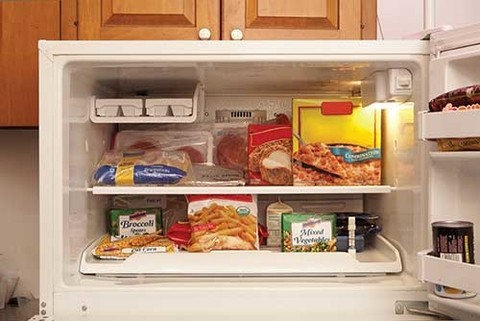Frozen food is a convenient way to preserve food and extend its shelf life. However, sometimes frozen food can thaw partially or completely due to various reasons, such as power outages or delays in getting them back into the freezer after shopping. This raises a critical question: How Long Can Frozen Food Sit Out Before Refreezing it safely? Understanding the safety guidelines is essential to prevent foodborne illnesses and ensure the quality of your food.
Refreezing Thawed Food: When is it Safe?
Generally, it is safe to refreeze frozen food that has thawed, whether raw or cooked, provided it has been kept at a safe temperature. Keep in mind that there might be a noticeable loss of quality. This degradation happens because thawing causes moisture loss, which impacts the texture and flavor.
To safely refreeze thawed food, ensure the product has been kept cold at 40°F (4°C) or below for no more than 3-4 days. If the food has completely thawed and warmed to room temperature, or if it has been left out of the refrigerator for more than 2 hours, it should be discarded to avoid the risk of bacterial growth. These rules apply to meat, poultry, seafood, and cooked dishes.
Vegetables
Many vegetables can be safely refrozen. However, their texture, flavor, and appearance may suffer significantly, even if ice crystals are still visible in the packaging. To minimize waste, consider cooking the thawed vegetables immediately and using them in dishes like soups or stews. You can then freeze the cooked soup or stew for later consumption.
Fruits
Thawed fruit and fruit juice concentrates can be refrozen if they still taste and smell good. Refreezing can negatively affect their appearance, flavor, and texture. A good alternative is to turn thawed fruits into jams or preserves to salvage their usability.
Baked Goods
Breads, cookies, and similar bakery items can generally be refrozen without posing a safety risk. However, refreezing may result in a drier, lower-quality product.
When Refreezing is Not Safe
As mentioned earlier, if food has been completely thawed, warmed to room temperature, or left out of the refrigerator for more than 2 hours, it is not safe to refreeze. This is crucial for preventing the growth of harmful bacteria. Ice cream and other similar frozen desserts should never be refrozen once they have thawed, as their texture and taste will be severely compromised and they can become a breeding ground for bacteria.
Prepared Foods
Thawed, but still cold, food mixtures such as casseroles, pot pies, frozen dinners, or pizzas can be cooked and consumed, but should not be refrozen.
Best Practices for Refreezing Food
To refreeze food safely and efficiently, follow these guidelines:
- Use the Coldest Part of Your Freezer: Place the food in the coldest section of your freezer to ensure rapid refreezing.
- Label and Date: Mark the refrozen food with the current date so you can keep track of how long it has been stored.
- Use Within 2-3 Months: Consume refrozen foods within 2 to 3 months to ensure the best quality and safety.
- Refreeze in Small Batches: If a large freezer has partially thawed, consider asking friends or neighbors to help refreeze smaller portions. Freezers can only refreeze a limited amount of food at a time effectively. Refreezing smaller amounts ensures that the food refreezes safely and reduces the formation of ice crystals.
Prioritize Safety and Quality
When deciding whether to refreeze foods, always prioritize safety first. If there is any doubt about the amount of time the food has been thawed or the temperature at which it was stored, it’s safer to discard the food. Secondly, consider the potential loss of quality. Some foods might degrade so much in texture and taste that refreezing them is not worthwhile.
Conclusion
Understanding how long can frozen food sit out before refreezing is vital for ensuring food safety and quality. By following the guidelines provided, you can make informed decisions about which foods can be safely refrozen and which should be discarded. Always remember that safety comes first, and when in doubt, it’s best to err on the side of caution. By prioritizing food safety and quality, you can reduce waste and ensure that your meals are both enjoyable and safe to consume.
